You need to hire to facilitate growth. But you need to grow in order to have the money to hire. So what do you do? Should you gamble by increasing your overheads before you've made enough money to afford it? Or wait until you're certain you can cover those overheads?
I inadvertently tried both—and neither one worked, at least not at first. What I learned was that it wasn't about when I hired, but more about how I hired.
Hiring before growth, then growing without hiring
I saved for two years while working in my 9-to-5 to be able to start my nail bar. Part of those funds were allocated to shop fitting and buying all the products. The other part was allocated to running costs and other overheads for the first six months while we found our footing.
This means I gave myself six months to become profitable (based on forecasts in my business plan). To justify those forecasts, I offered every service I could fit on the pricing menu: manis, pedis, waxing, makeup, brow shaping, lash extensions, facials, and massages.
I then filled all my work stations by hiring a mix of experienced nail technicians and cosmetologists. I spent time and money giving them product-specific training to successfully do their job. Their salaries were commission-based since they were all in direct income-generating roles. And my role was to focus on strategy and growth. Everything was outlined according to my business plan.
But as it turns out, my business plan had nothing to do with reality.
Once clients started coming in, it wasn't long before we started getting complaints. My staff, even with their combined training, experience, and qualifications, offered mediocre service and failed to meet clients' expectations. This led to low retention rates. The low retention rates led to lower pay since commissions were low. All five staff quit within short notice. Nothing could have prepared me for this, but the show had to go on.
To avoid becoming a small business failure statistic, I had to roll up my sleeves and do everything myself. Coming from a corporate background, I didn't know anything about cosmetology except the videos and tutorials I'd seen on YouTube. I had to learn fast. I wore all the hats: I was setting up appointments, doing client work, handling customer queries, marketing, bookkeeping, and social media, among a plethora of other tasks that never seemed to end.

To say that I needed help would be an understatement. But I'd also been burnt by hiring before. Plus, my savings had run out, and I was barely making enough to pay overheads.
I was caught between a rock and a hard place. Do I bite the bullet and hire again? Or try to be more productive and keep pressing on until I made enough money to hire someone else? After having made classic rookie mistakes, I went through a very steep learning curve. But I finally got it right. Here's how.
Start small
It sounds obvious, but starting small is underrated. When I thought of quitting my job to start a business, I was thinking big. And thinking big is fine—but you still need to start small. I tried to run before I knew how to crawl.
Narrow your focus to one key thing that you know you're good at—and become known for that. For me, it meant changing my business model. We went from being a beauty lounge and trying to do everything, to focusing on gel manicures and specializing in nail enhancements and art. That's how we became known as the nail bar.
Here's why that was important when it came to hiring:
Specializing helped me better assess the quality of applicants' work. I knew the craft well, so I knew exactly what to look for.
Starting small allowed me to experiment with what worked and what didn't. I tested my idea on a smaller scale where the stakes weren't as high, and I got immediate feedback from customers. That meant I wouldn't overhire only to find out I had hired wrong (like the first time).
With fewer processes, it was easier to train new hires.
On my third try, I hired one person. I had three empty workstations to fill, but I worked with just one other employee until I was sure that my strategy would bring sustainable results. I didn't hire again until our retention rate was high enough and we had enough revenue to warrant the further increase in overheads.
Focus on projects
One of my goals was to increase awareness of the newly branded nail bar. But goals can be squishy, so instead, I broke it down into projects—which helped me figure out if I would need help.
I had four projects all aimed at increasing awareness: handing out flyers at government buildings, private offices, and schools before proms; sponsoring vouchers at leading events in exchange for publicity; posting more on social media; and optimizing my Google My Business site.
Two of these projects could be automated, and the other two I could do myself. If one of my projects had been experimenting with paid advertising, then I'd have had to hire. I'd look for someone who was skilled with PPC campaigns and use their services, instead of spending six months trying to learn how to do it myself. By breaking it down into projects, I was better able to see if hiring was necessary.
Separate operational tasks from strategic tasks
On any given day, I was putting out more fires than doing actual meaningful work. From addressing the wrong inventory delivered by suppliers to being on the phone with my internet service provider, there were always problems tugging at me.
Think about what's filling up your plate in a day. How many of those tasks are operational, focused on the everyday running and management of the business? How many are strategic, focused on growing the business and taking advantage of market opportunities?
Of course, you have to do both. Bookkeeping is an important operational task, but it won't help to keep books when there are no sales. Working on a giveaway to increase awareness is also important, but not having up-to-date books could land you in hot water when it's time to file taxes.
So what should you do?
I suggest spending 20% of your time (one day a week) on strategic tasks, and give yourself 80% of your time for operational tasks. According to the 80/20 rule, that 20% will actually have 80% of the impact, and that's a good thing. Then you still have 80% of your week left to run the business—which has to be done.
If 80% of your time isn't enough to run the business, then it's time to hire.
Document processes
I'm a big fan of standard operating procedures. Once you've mapped out your processes, it will be easier to identify which ones you'll handle, which ones you can automate, and which ones need a new hire (not to mention which ones you really don't need to be doing at all).
Having processes in place also made me more confident that I could leave my hires to do their job while I focused on mine.
If you're not sure when to automate a task, start here. Then take a look at these 5 things you should automate today.
Consider a contractor
Hiring an employee is expensive. Make sure you've properly evaluated the costs before taking the plunge. You don't only need to account for their salary but also the cost of training, taxes, and benefits.
But remember, you don't need to commit to a full-time hire right off the bat. You can get a virtual assistant or freelancer who will come in on a contract or project basis. You can assign them an entire project, or you can test the waters by delegating specific tasks within a project. This allows you to see if someone's a good fit—and if the role is even necessary—before making a permanent hire.
I actually had practical interviews, where I booked someone out for the day and let them service clients. I looked at their interactions with clients and the quality of their work. At the end of the day, I paid them for the work done. Later, I called the clients and asked if they would be happy working with the candidate—this helped me get second opinions from the people that mattered.
If you decide to go the permanent route, most labor laws allow you to have a 90-day period where you can hire someone on probation. This way, if things aren't working out, you can find someone else. The small business hiring guide takes you through the process step-by-step, but here are some things I found helpful when hiring:
Only hire when all the tasks you need done fall under one particular skill set. It doesn't make sense to hire someone to create content and serve clients and do bookkeeping. Those skills are too divergent, and chances are you won't be able to find someone who'll excel at all three.
Make sure that your hire will be performing tasks that help you generate income. Any new business should be concerned with making money. Your first hires should be helping you generate income—look for apps and automation to fill in the cracks.
Find someone who is resourceful. Your first hire is going to be your most important hire: choose someone who will take the initiative to help you solve problems and find better ways to do things.
Have a proper onboarding process. Make sure your first hire sees the big picture and the details. They need to understand your vision, and you need to train them on the details.
There's no one answer to the tough question of when (or if!) to hire. But by starting small, understanding your tasks, and auditing your processes, you'll be in a better position to know if you actually need the help.
Read more: 5 reference check questions you should always ask





